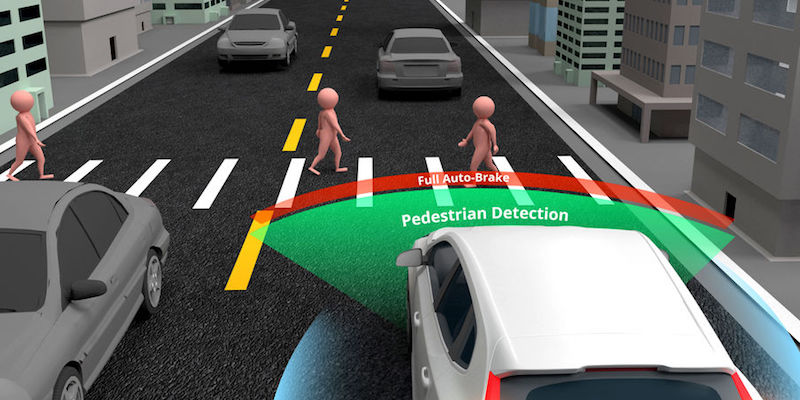At least 89 pedestrians died from auto accidents on Colorado streets, roads and highways in 2018, preliminary tests show. New auto-braking systems could reduce the number of future deaths.
Safety Lab Creates New Standards for the Safety Tech
An automotive safety laboratory, whose growing list of safety standards has been shaping development of new cars and trucks, will begin issuing ratings on how well vehicles can see and avoid pedestrians — both adults and children — in the roadway.
The Insurance Institute for Highway Safety (IIHS) will begin issuing ratings on the effectiveness of systems currently available in some cars and trucks in the next few months, the testing laboratory announced.
IIHS, most widely known for its annual Top Safety Picks and Top Safety Picks-Plus ratings, released its list for 2019-model cars in December 2018. Automakers covet the top honors and use them as key selling points in their advertising. To maintain their place or receive a higher rating, manufacturers have been adding new and improved safety features, such as better headlights, auto-braking systems, and structural improvements for passenger safety.
Manufacturers have been including crash-avoidance systems in some high-end models for several years. The systems use a series of cameras and other sensors, such as infrared and radar, to detect other cars and obstacles in the road and give alerts or even apply the brakes to avoid a car accident.
It’s easy to see why a system would have an easier time seeing and avoiding a collision with a car than it would with something smaller, such as a deer, a bicyclist, or a person walking on the road. So the new testing is holding the old systems to a higher standard and could force manufacturers to improve them or add new systems.
The pedestrian autobrake test will become the fourth part of IIHS’ crash-avoidance evaluation regimen. The lab already tests for front-crash prevention, rear-crash prevention, and headlight effectiveness.
The first test subjects, 11 small sport-utility vehicles from 2018 and 2019, will be rated for basic, advanced or superior effectiveness in avoiding or reducing the simulated harm of crashes with pedestrian dummies at various speeds and in different scenarios. In one such test, a child-sized mannequin will be set up to “run” across the road from between two parked cars — any driver’s greatest nightmare.
According to IIHS Testing Manager David Aylor:
“The test with the small child dummy is the toughest. […] The dummy is hidden by a car and an SUV parked on the right side of the road as the test vehicle approaches, so there’s no clear sight line for the cameras — or driver — until the dummy emerges in the vehicle’s path.”
About one-third of all 2019 cars and trucks have an autobraking system with pedestrian-detection capabilities as a standard feature. The systems are optional equipment on another third of this year’s models.
Autobraking Already Making a Difference
The pedestrian-detection and braking systems do help prevent the crashes, IHHS said. Its sister organization, the Highway Loss Data Institute, published a report in 2018 showing that Subaru vehicles with pedestrian detection systems had 35 percent less in insurance claims for pedestrian injuries than the same cars and trucks without the systems.
A 2011 report by IIHS projected that the systems could potentially reduce or lessen the severity of as much as 65 percent of single-vehicle crashes with individuals and eliminate 58 percent of pedestrian deaths in the crashes.
Severe Problem in Colorado and Across the Nation
IIHS and the Governors Highway Safety Association both cited statistics showing that about 6,000 pedestrians died from accidents on U.S. streets, roads, and highways in 2017. Of those, 170 were children younger than 13. Although pedestrian road deaths are 20 percent lower than they were in 1975, they have increased by about 45 percent since their low point in 2009.
Preliminary statistics from the Colorado Department of Transportation show that at least 89 pedestrians died in crashes in 2018, a slight decrease from final results from the prior year. However, the state agency will probably adjust its numbers over the next several weeks as more reports are added to the tally.
The lowest number of pedestrian deaths since 2002 occurred in 2010, when only 40 were killed.

